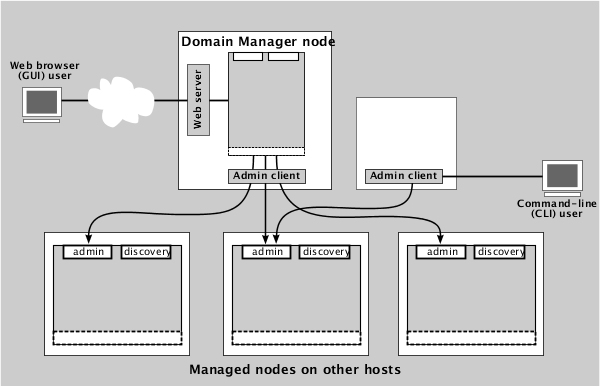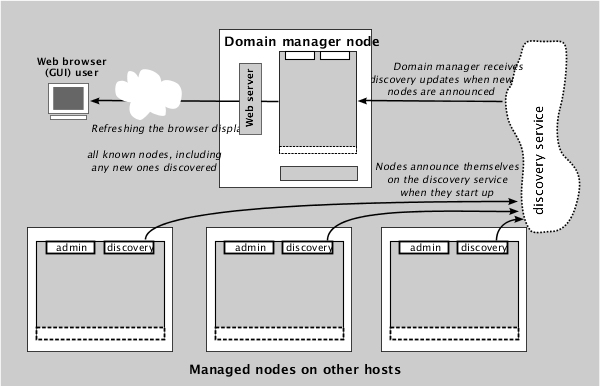This section provides a brief overview of the ActiveSpaces® Transactions management architectural concepts.
ActiveSpaces® Transactions nodes are grouped into domains. A domain provides a single point of administration for multiple nodes. Domains will be discussed in more detail later in this chapter.
Each ActiveSpaces® Transactions node has an administration port; this is a unique network port where the node listens for incoming administration requests. Requests on this administration port are used to control all configuration and state on that node.
For the sake of versatility, the following different administration clients are available:
A graphical (GUI) administration client provided by ActiveSpaces® Transactions Administrator
A command-line interface (CLI) provided by the
administratorcommand
Any off-the-shelf JMX management console may also be used to manage ActiveSpaces® Transactions nodes.
Figure 3.2, “Basic management architecture” shows how both of the command line and GUI may be used to control nodes via their administration ports. The use of these clients is described in ActiveSpaces® Transactions Administration Guide.
In general, the GUI client is easier to use interactively and the CLI client provides other advantages such as scriptability. For most of the remainder of this guide, diagrams will show only the GUI client, but it is always possible to use the CLI client instead.
![[Note]](images/note.png) | |
The GUI and CLI clients provide equivalent capability. In fact, ActiveSpaces® Transactions Administrator uses the CLI capabilities to control nodes as shown in Figure 3.2, “Basic management architecture”. |
Each node within an ActiveSpaces® Transactions business solution starts and runs as an instance of a particular application.
When a node is created, it publishes itself to a discovery service. The published service name has a service type of node and is uses the node name as the service name. Along with the service name, a node also publishes a set of properties that are useful to the domain manager to perform automatic discovery of nodes. The properties are:
Host name - the network address of the host where the node is running.
Administration port - the node administration port.
Node agent listener network address - the listener address of the node agent. The domain manager event cache uses this information to access log messages from the node (see the section called “Centralized log messages”).
Node description - a node description.
Default requested domain name - the name of the domain that will manage this node automatically if the domain is running.
Default requested group name - the name of the group to which this node will be added if the group is defined on the requested domain.
Both the GUI and CLI management clients use the discovery service to find these nodes within the network; access to a node can be done using its service name alone, without using the host name and administration port.
Service discovery is also used by distribution to locate remote nodes. When a node starts it also publishes a service name with a service type of distribution. The published distribution service name contains these properties:
Network address - distribution listener address.
Location code - location code of node.
See the section called “Location discovery” for details on how distribution uses service discovery.

